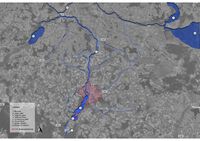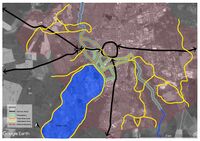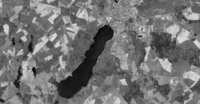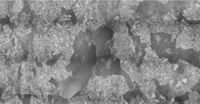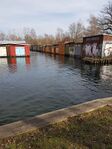WAVE Living Lab Neubrandenburg 2021
>>>back to working groups overview
| Area | Tollense Lake | |
| Place | Neubrandenburg | |
| Country | Germany | |
| Topics | please enter the main topics of your living lab | |
| Author(s) | Please enter your name(s)- optional | |

| ||
Rationale
- Why do you think this case is relevant? What is your hypothesis considering the landscape challenges?
- Format: 3-4 sentences
Location and scope
You can edit this map with the map editor
Water as a natural system
Geomorphology, typologies and dynamics of water areas
- Tollense Lake in Wider Water System
Tollense Lake is located Southwest of the city of Neubrandenburg, Mecklenburg-Western Pomerania, Germany. It has a length of 11 Km and a width of 2.5 m. The Tollense Lake has an area of 17.350 km2 and a depth of 34 m and it lies in an ice age tunnel valley. It is well-known for family spot holidays caused it rated as good quality of water, which means people are allowed to swim in the Lake. Tollense Lake is a very important water area due to its connectivity. It connects to the Tollense River which is the right tributary of the Peene river. From Peene River the river flows to Szczecin Lagoon and Achterwasser, Achterwasser has direct connectivity to the Baltic Sea. Towards Southwest of Tollense Lake, there is a village called Blumenholz. In Blummenholz, Mürzsee is the beginning of upstream of Tollense River. From Mürzsee, a river called Zimmenbach flows into Lieps Lake. From Lieps Lake, Alter Graben River flows from Lieps Lake into Tollense Lake. From Tollense Lake, it has two branches of Oberbach and Ölmühlenbach then both flow into Tollense River. Both branches unite after approximately 1.6 Km.
- Catchment Area, Tributaries, Floodplains of Tollense Lake
The Tollense Lake has the longest and most water-rich tributary called Nonnenbach, while the Tollense river has tributaries such as Lindebach. Lindebach is one of the important tributaries due to its flow reaching the Lindetal district, eastern of Neubrandenburg. Another important tributaries is Datze river on the North of Neubrandenburg, Torneybach, gold Bach, Großer Landgraber and Augraben river that are near to Demmin (the end of Tollense River). According to the Geoportal website of Mecklenburg Vorpommern, the floodplains of Tollense Lake and Tollense River are mapped mostly adjacent to part of the built area of the city. The catchment area is shown in the picture below.
- Dynamics of Tollense Lake
In 1900, there was 10,500 inhabitant in Neubrandenburg. It grew to 30,449 inhabitants in 1958. As the picture below, the built area was dense near to inner ring of the city, while the green area was dominated around Tollense Lake. In 1991, the built area was developed into the Northeast of Tollense Lake. Presently, the built area has grown into the East and the Northwest of Tollense Lake. In summary, the South, Southeast, and Southwest area of Tollense Lake are still dominated by green areas. The Tollense Lake was formed during the last Ice Age, 15.000 years ago or more than Vistula Ice Age. During Ice Age, the landscape was chains of hills, sand areas, numerous streams, and smaller lakes. Tollense Lake is derived from the Slavic "dolenzia” which means Lowland. The landscape area of Tollense Lake has been known as a glacier tongue basin over a longer period of time. The Tollense Lake is famous for a family holiday spot. There are facilities around the lake that responded to the modern needs of citizens and tourists, the facilities such as passenger shipping, restaurants, cafes, cycling route, and areas for swimming have currently existed.
There was no flood event as recorded around Tollense Lake and Tollense River. However, there is a potential risk of flooding that is mapped below. The water level of this area is rated from Normal to High, and has not reached a warning level.
In Neubrandenburg, we mostly find water canals that originate from the Tollense Lake, which creates a harmonious water system which is connected and refreshing. Water in Neubrandenburg comes mainly from the Tollense river, a freshly mixture of various sea and freshwater sources, in the landscaping area, the Tollense supplies the water canals all the necessities for agricultural production and offers opportunities for new agricultural experiments, thus playing a key role in shaping the environment by establishing a dominant river valley that connects the entire city of Neubrandenburg with its water sources.
Water as a living space
- Which habitats can be found in and along the water areas of your area?
- How is the water quality in your water areas?
- Which areas are still natural, which are urbanised/artificial?
The significant changes in the areas around is the growth of population and depletion of forest and farmland mainly toward the north-western side of the lake. The addition of recreational spaces and landscape activities serve the tourist attraction to the Tollensesee. Among the artificial structures like bridges ,pathways , playgrounds ,cemetery , restaurants and fish ladder, boat club on the Oberbach , and the Fisherman's house are tourist attractions.
Fish ladder
A fish ladder, also known as a fishway, fish pass or fish steps, is a structure on or around artificial and natural barriers (such as dams,locks and waterfalls) to facilitate diadromous fishes natural migration as well as movement of potamodromous species . Most fishways enable fish to pass around the barriers by swimming and leaping up a series of relatively low steps (hence the term ladder) into the waters on the other side. The velocity of water falling over the steps has to be great enough to attract the fish to the ladder, but it cannot be so great that it washes fish back downstream or exhausts them to the point of inability to continue their journey upriver.
'Fisherman's house on the fishing island in Lake Tollense'
The island in the southern part of Lake Tollense in Mecklenburg-Western Pomerania can already look back on a long history, the listed fisherman's house tells of this only the last section of the dwelling of the fishermen since the 18th century, which is still visible today. In addition to the authentic experience of the historical development of this region, nature conservation also plays an important role. If a long-term conservation perspective is to be developed for the building, which has been vacant for more than 20 years, a compromise must be sought, which will certainly only be found with mutual understanding and constructive dialogue and a responsible owner. According to the council minutes of the city of Neubrandenburg from 1729, the proposal to build a new house on the fishing island in the southern Tollensesee can be found. The construction is decided and carried out by Zimmermann Tröger. Fishing on Lake Tollense played a decisive role in the nutrition of the population for a long time, the island served as a shelter and refuge for the fishermen in GDR times. The two-storey and at the core baroque half-timbered building with splet roof has a wide central hallway with a brick stove and allows its structure according to the comparison to the so-called Ernhäuser (Middle German cross-floor houses).
The building is still owned by the city of Neubrandenburg – probably one of the oldest municipally owned residential buildings in the country. After a last backup was carried out in 2006 as part of an AB measure, the stock is now, 14 years later, acutely endangered again by the progressive decline and long vacancy favoured in a remote situation. Currently, the implementation of an emergency security with financial support of the State Office for Culture and Monument Conservation Mecklenburg-Vorpommern is planned.
- Are the rivers permeable for fish or blocked by artificial elements?(approx 200 signs)
- add 1-2 graphical representations to the image gallery, you can add more if you like
- Yourcase wateraslivingspace1.jpg
add a caption
- Yourcase wateraslivingspace2.jpg
add a caption
- Yourcase wateraslivingspace3.jpg
add a caption
Blue and Green Infrastructure
- What are the major potential elements of a green/blue infrastructure network? Are these likely to change/disappear? Why is that?
- You find my background material on green infrastructure in our reading list
- add 1-2 graphical representations to the image gallery, you can add more if you like
- Neubrandenburg Green and blue infrastructure.jpg''add a caption''
- Your case green blue infrastructure2.jpg
add a caption
- Example.jpg
Neubrandenburg Green and blue infrastructure
- Example.jpg
Caption2
Water as a cultural space
Land use and water
- map the land uses along your water areas: settlements, infrastructure, agriculture, resource extraction, natural areas, energy production...
- describe in particular the historical evolution of land use pattern, please make use of historical maps
- description evolution, status quo and driving forces, is the land use likely to change? Why is that? (approx 200 signs)
- add 1-2 graphical representations to the image gallery, you can add more if you like
- Yourcase landuse1.jpg
add a caption
- Yourcase landuse2.jpg
add a caption
- Yourcase landuse3.jpg
add a caption
Cultural and spatial typologies of water areas
- Which spatial patterns have evolved in relation to your water areas?
- What is the role of water areas within the overall urban morphology? (approx 200 signs)
- add 1-2 graphical representations to the image gallery, you can add more if you like
- Yourcase water space1.jpg
add a caption
- Yourcase water space2.jpg
add a caption
- Yourcase water space3.jpg
add a caption
Sacred spaces and heritage
- Fischer Island
Fisher Island is a small island located in the Southwest of Tollense Lake, in front of the city of Penzlin. The island has 150 m in length, 40 m wide, and currently covered by vegetation. In the middle of the island, a fishing hut was built in 1729 and still used in 1970 by fishermen who spent a night. The island was believed to be a center of the Slavic tribe Veleti-Rethra. In 1969, the Archeologist found a figure of Lel and Polel. It is a cult of twin deities of Slavic mythology. In 1977, Hartmut Boeck, a German archaeologist discovered a 40m x 14m rectangular place in the Northeastern Island. In 1905, an excavation by Gustav Oesten found pieces of charcoal and ceramic shells in that place, it indicates a settlement of Slavic worship. It is believed an island is a place of Rethra, the main town, political center, major worship center of Slavic Redarians (one of Lutician tribes)
- Belvedere
Belvedere is located on the North shore of Tollense Lake. In 1775 the Duke of Mecklenburg-Strelitz, Adolf Friedrich IV. built a summer house on a hill. Until then, it was torn down. However, in 1823 grand duke Marie built a summer house at this place in the form of a Greek temple. The house was designed by Wilhelm Buttel. In 1934 Belvedere is converted into a memorial for the dead soldiers of the First World War from Mecklenburg-Strelitz by the architect Heinrich Tessenow. In 1995 the building was restored as an open temple.
- Amthouse Broda
Amthouse Broda is one of the oldest buildings in Neubrandenburg. A monastery of the Premonstratensian friars was built in In founded around 1170. The construction took time in 1230 and 1240. It is later converted into an official residence Broda with a manorial economy. In the 17 century, this medieval building was almost collapsed. In 20 century, Amthouse Broda was restored as a residential and office building. In 2004 it has been functioned as a guesthouse for International scientists by Hochschule Neubrandenburg.
- The Alter Friedhof
The cemetery of Alter Friedhof is located at the Tollense Lake at Seestrasse, it is a quiet and also a hidden area where the graves are positionned fronting the Tollense lake at the playground directly in front of it called the open Seeperle playground where families get together and play with their kids. The graves have recently been renewed, located within a wide green space with tall trees who seem like they’re protecting the entire area. This sacred place presents its self also by paying respects to the dead of the victims of the world war 2 which has had major and dire effects on the four gated city of Neubrandenburg in which many souls were sadly either sacrificed or murdered in the infamous year of 1945, this space has a very high value, it is considered to be a silent highly valuable sacred space at the Tollense Lake.
Visual appearance and landscape narrative
- Which elements are essential for the landscape character?
- Has the landscape been painted or otherwise depicted, when and whom? Which elements are essential?
- Which narratives exist? Who has written about this landscape or depicted it in some way?
- You can add text and images
- Your case character1.jpg
add a caption
- Your case character2.jpg
add a caption
- Your case character3.jpg
add a caption
Water and People
Accessibility and usability
- Where are your water areas accessible, and where not? How strong are spatial obstacles preventing access?
- Who is using the spaces and how?
- Yourcase youraccessbilitymap.jpg
add a caption
- Yourcase usepatterns.jpg
add a caption
Community Mapping
What is to be mapped here?
- Social groups from within the community, for example the youth, kids, students, parents, the retired etc. Typically, these groups have specific needs, which you can also make explicit on the map. These people might not be organized in any way, but they are usually present in the context you are observing
- Local stakeholder groups: these groups are organized in one or the other way. They only exist within the community context you are observing. For example: the local community center, local churches, local interest groups, the landowners, small businesses and retailers
- External stakeholder groups are not necessarily present in the environment you are observing, but they may have strong stakes and interests. These can be local authorities, politicians, associations, care services etc.
- For each group, you may identify their needs, objectives, power and capacities
- You may also identify gaps and power conflicts
- Please try to redepict these elements in an integrated way and in relation to your water landscape. What is the relationship between these groups? Are they close or distanced from each other? Who is more powerful? Which voices are hardly heard? Do they have any shared concerns?
- Your case your community map1.jpg
add a caption
- Your case your community map2.jpg
add a caption
- Your case your community map3.jpg
add a caption
Possible Futures
- You can summarize your findings with a SWOT diagram and a DPSI(R) Model
- Link back to the Sustainable Development Goals: Which goals are at risk?
- What is your worst case scenario for this landscape?
- What is your best case scenario for this landscape?
- Present your scenarios in the form of a collage or sketch
- Add text and visuals
- Your case your spider diagram or dpsir model.jpg
explain your analysis briefly in the caption
- Your case yourworstcase visual.jpg
explain your worst case scenario briefly in the caption
- Your case yourbestcase visual.jpg
explain your best case scenario briefly in the caption
Collaborative Goal Setting
- Define strategic planning objectives based on the evaluation findings from your analysis
- Ideally, involve the community of your living labs into this process
- Link back to your original targets from section one and the Development Goals
- 150 words text contribution
Spatial Strategy and Transect
- translate your strategic goals into a vision
- develop a spatial translation of your vision
- exemplify your vision in the form of a transect with concrete interventions
- add map(s) and visualizations
- Your case spatial translaton vision.jpg
add caption here
- Your case transect.jpg
add caption here
- Your case transect detail1.jpg
add caption here
- Your case transect detail2.jpg
add caption here
From Theory of Change to Implementation
- For implementing your vision: Which partnerships are needed? Which governance model is required?
- Who needs to act and how? Draw and explain a change/process model/timeline
- Which resources are needed? On which assets can you build?
- add 150 words text and visuals
References
- give a full list of the references you have used for your case
Process Reflection
- Reflect in your intercultural and interdisciplinary team on the outcomes of your study
- Which limitations were you facing?
- What have you learnt from each other?
- What did you learn in the Living Labs?
- What would you do differently next time?
- You can also use diagrams/visuals
- 250 words text
